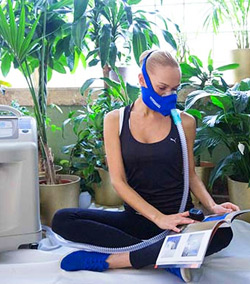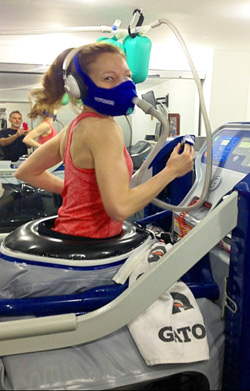On 28 August 2004 the Moroccan Hicham El Guerrouj won the men’s 5,000m Olympic final in a time of 13:14.39. The race had been close: only 10 seconds separated the first seven competitors, and less than one second had divided the medallists. In elite endurance events such as the 5,000m, where seconds can make the difference between success and failure, it is no surprise to learn that athletes and coaches are constantly striving for legitimate advantage over their rivals.
In the early 1990s, Benjamin Levine, a researcher at the University of Texas, seemed to have made such a discovery. By exposing college athletes to low concentrations of oxygen (hypoxia) during rest, and normal conditions (normoxia) during exercise, Levine and his colleagues were able to show that 5,000m times could be improved by an average of 13.4 seconds in elite college athletes. Although this ‘live high, train low’ approach to intermittent hypoxic training (IHT) is now widely used by endurance athletes across the world, a number of problems and controversies still exist with the technique. Here, we look at the issues and provide some practical guidance for those who wish to incorporate this technique into their training programme.
Air pressure: the basics
It is worth spending a few moments considering the movement of oxygen inside the body. Unlike solids and liquids, gases expand in all directions and occupy the space in which they’re contained. This makes units of weight and volume redundant; instead gases are measured in units of pressure. In an enclosed space filled with gas, molecules are continually colliding with each other and the walls that contain them. As more gas molecules are added, the collisions become more frequent and the pressure exerted on the walls of their container increases. This pressure can be expressed in a host of different units. Here, I use two common units: the kilopascal (KPa) and the millimetre of mercury (mmHg).
At sea level the pressure exerted by all the gases in the atmosphere (nitrogen, oxygen, carbon dioxide and a host of rare gases) adds up to 101 KPa (760 mmHg). As 21% of the atmosphere is made up of oxygen, the pressure exerted by oxygen alone (often referred to as the ‘partial pressure of oxygen’) is approx 21 KPa (160 mmHg).
As you climb to altitude, the number of molecules in the atmosphere falls, leading to fewer collisions and a fall in pressure. On the summit of Mt Kilimanjaro (5,895m) the atmospheric pressure is 50 KPa (380 mmHg); on Mt Everest (8,850m) the atmospheric pressure stands even lower at 34 KPa (253 mmHg).
Despite these tremendous changes, the proportion of each gas in the atmosphere remains the same. Therefore, to calculate the partial pressure of oxygen the atmospheric pressure is multiplied by the proportion of oxygen (0.21).
Clearly, the simplest way to expose athletes to hypoxia is to encourage them to live at altitude. Unfortunately, this often proves too costly and time consuming, so two alternatives are available:
*Hypobaric chamber: These devices are constructed from reinforced steel and are usually operated by medical specialists. They work by removing an equal proportion of gases from the chamber, thereby reducing the atmospheric pressure inside. This is exactly what happens during a climb to altitude.
*Hypoxic device: Instead of lowering pressure, these devices remove only oxygen and replace the missing space with nitrogen gas. This maintains a normal atmospheric pressure whilst reducing the partial pressure of oxygen, creating a hypoxic environment at sea level. This arrangement is much simpler to organise than a hypobaric chamber and is the easiest way for sea level athletes to experience hypoxic conditions. Such devices come in all shapes and sizes, from large living quarters to small portable face mask systems.
However, it is not yet clear whether these systems produce the same responses as those seen in Levine’s volunteers.
 Why is all this important? In order for gases to move into the lungs there needs to be a pressure difference. The greater the pressure difference, the greater the movement of gas. Think of the rapid movement of air when a large party balloon is burst. As the air inside is at a much higher pressure than its surroundings, when the balloon bursts the molecules at high pressure pass easily into the atmosphere. In the same way, at sea level the partial pressure of oxygen is much higher in the atmosphere than inside the body (normally 12 KPa or 99 mmHg), so oxygen therefore moves eagerly down the body’s airways, through the blood stream and into the tissues. However, at high altitude, the partial pressure of oxygen in the atmosphere is much lower and the movement of gas through the body and into the cells is much, much slower. In order to cope with this challenge, the body adapts in two ways. Firstly, it improves oxygen delivery to the cells, and secondly it encourages the various cells themselves to cope with smaller amounts of oxygen. It is these adaptations that are harnessed by a ‘live high, train low’ regime to improve aerobic performance at sea level.
Why is all this important? In order for gases to move into the lungs there needs to be a pressure difference. The greater the pressure difference, the greater the movement of gas. Think of the rapid movement of air when a large party balloon is burst. As the air inside is at a much higher pressure than its surroundings, when the balloon bursts the molecules at high pressure pass easily into the atmosphere. In the same way, at sea level the partial pressure of oxygen is much higher in the atmosphere than inside the body (normally 12 KPa or 99 mmHg), so oxygen therefore moves eagerly down the body’s airways, through the blood stream and into the tissues. However, at high altitude, the partial pressure of oxygen in the atmosphere is much lower and the movement of gas through the body and into the cells is much, much slower. In order to cope with this challenge, the body adapts in two ways. Firstly, it improves oxygen delivery to the cells, and secondly it encourages the various cells themselves to cope with smaller amounts of oxygen. It is these adaptations that are harnessed by a ‘live high, train low’ regime to improve aerobic performance at sea level.
According to the eminent physiologist John West, ‘The underlying rationale is that sleeping at high altitude increases the red cell concentration of the blood and thus endows some advantage, whereas the actual training should be at sea level where the aerobic machinery can be driven to its maximum.’ Let’s take the two points raised by West in turn.
i. Changes in red cell concentration
After just two hours of breathing 10% oxygen, the first physiological changes can be seen in the circulation. The production of erythropoietin, a hormone synthesised by the kidneys, rapidly increases and immediately sets to work coaxing the bone marrow into releasing large quantities of red blood cells. For the athlete, this is great news as an increase in red cell concentration means a rise in the oxygen-carrying capacity of the blood and a fall in cardiac output (the amount of blood ejected by the heart in a minute), which results in the tissues having a longer period of time to extract oxygen. The end result is something not far from finding the Holy Grail: an increase in the maximum oxygen consumption (VO2 max) and, with it, a rise in the athlete’s maximum work rate.
In addition to this profound change, a number of studies have also pointed towards other adaptations that occur within the muscles themselves. This is hardly surprising as hypoxia triggers the activation of HIF-1? (hypoxic inducible factor -1?), which is responsible for stimulating the production of proteins from a range of different genes.
ii. Training at sea level
In a series of experiments, Levine and his colleagues found that resting and training at altitude (‘live high, train high’) fails to produce improvements in performance. Although training in a hypoxic environment feels considerably harder than at sea level, athletes are unable to reach their maximum work rates or levels of oxygen consumption. This is like driving a car at speed in third gear – although it feels much harder, progress is slow.
When healthy, well acclimatised volunteers ascend to altitude, VO2 max falls prodigiously. This inability to use oxygen at higher altitudes results in a fall in maximum aerobic power of approx 1% for every 100m gained above 1,500m of altitude. Therefore, the end result for any athlete who trains at high altitude for any length of time is a fall in the levels of exercise intensity and a general reduction in their overall level of physical fitness.
The evidence for ‘live high, train low’
With more than 15 years of evidence now available, we still have uncertainty and controversy, as well as areas of agreement in the research. Three preliminary observations are worth making:
i. Quality: Quality research in this area is expensive and time consuming. The best studies have been funded by substantial grants from either the International Olympic Committee or national sports agencies. Much of the work is otherwise poorly financed and this is reflected in the small sample sizes, absence of control groups and insufficient follow-up times that characterise many of these studies. Any conclusions drawn from such work need to be treated with a great deal of caution and are mostly avoided here.
ii. Participation: Most participants in ‘live high, train low’ trials are young, white and male elite athletes. This makes it difficult to apply these results to a wider spectrum of the ‘normal’ population.
iii. Specificity: The majority of work has focused upon the performance of middle distance runners. Although some work has been undertaken on other elite endurance athletes (skiers, swimmers and cyclists), it would be a leap of faith to apply the findings to other endurance events.
How much hypoxia is good?
 From the limited evidence available, an altitude of between 1,600m and 3,000m seems necessary to generate a consistent increase in red cell concentration. At altitudes below 1,600m there is little change, while above 3,000m athletes run the risk of incurring problems that can cancel out any potential improvements they have gained.
From the limited evidence available, an altitude of between 1,600m and 3,000m seems necessary to generate a consistent increase in red cell concentration. At altitudes below 1,600m there is little change, while above 3,000m athletes run the risk of incurring problems that can cancel out any potential improvements they have gained.
In order to obtain improvements in red cell concentration, VO2max and athletic performance, Levine’s athletes lived at an altitude of 2,500m (equivalent to 16% oxygen) for up to 20 hours a day while training at sea level, for four weeks. Few studies have come close to emulating such a lengthy period of exposure, but the results from those that have are worth mentioning here. Despite some agreement with Levine’s findings, a number of studies have shown either no improvement or have identified enhancements in performance without a change in red cell concentrations.
Recent research has shown that the HIF-1?protein not only stimulates the formation of red cells but has also been linked with improvements in muscle efficiency. This is characterised by improvements in blood flow, the supply of glucose and the clearance of lactic acid from working muscles. These changes may be of considerable benefit to the Olympic 5,000m finalist and therefore offer a clear advantage over a simple blood transfusion or ‘blood doping’, which often occurs before major sporting events.
Video
Disclaimer
The Content is not intended to be a substitute for professional medical advice, diagnosis, or treatment. Always seek the advice of your physician or other qualified health provider with any questions you may have regarding a medical condition.
